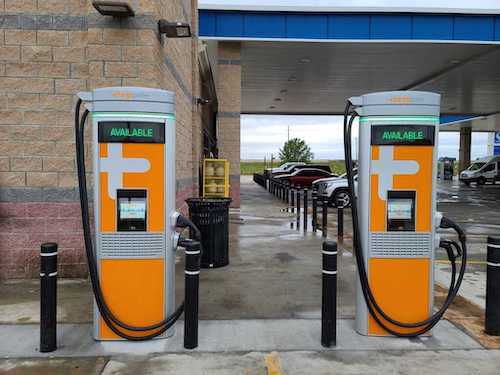Charging Electric Vehicles in Public

General public charging uses Level 2 (shown here) or DC fast charging.
For fleet drivers and consumers to charge their electric vehicles (EVs)—which include all-electric vehicles and plug-in hybrid electric vehicles (PHEVs)—in public, charging stations must be deployed and integrated based on local community needs.
Charging Stations
Public charging stations make EVs more convenient. Although the majority of EV owners charge at home, public charging and workplace charging stations can increase the daily useful range of all-electric vehicles and reduce the amount of gasoline consumed by PHEVs.
General public charging uses Level 2 or DC fast charging. Level 1 and 2 charging stations should typically be located where vehicle owners are highly concentrated and parked for long periods of time, such as shopping centers, airports, hotels, government offices, and other businesses. Public charging should also be located along highway corridors or at urban charging hubs.
Learn about charging infrastructure development and operation and maintenance, and read a case study on public charging station procurement. For more information about infrastructure costs and charging infrastructure development, refer to Costs Associated With Non-Residential Electric Vehicle Supply Equipment and a review of charging infrastructure costs.
Fleet Charging
Fleets that choose to incorporate EVs into their operations must consider several factors when planning for charging stations. Peak demand, duty cycles, garaging locations, vehicle models, and availability of off-site public charging stations can all factor into decisions about the number, location, and type(s) of charging units. City planners, fleet managers, and utilities can work together with installers to determine the best charging solutions.
Fleets around the country are adopting EVs for light-, medium-, and heavy-duty vehicle applications. Transit agencies, municipalities, and commercial fleets are also poised to make a significant transition to EVs. To prepare for and support this transition, several utilities have published fleet electrification guidance, such as Pacific Gas and Electric’s Take Charge: A Guidebook to Fleet Electrification and Infrastructure. Learn more about fleet electrification.
Building Codes, Parking Ordinances, and Zoning Ordinances
Building codes as well as parking and zoning ordinances are all regulatory tools at the disposal of state and local officials to further the EV readiness of communities. Each has a different potential role to play and can be used in tandem to encourage the adoption of vehicle charging infrastructure.
- Building Codes: Building codes ensure construction meets fire, electrical, plumbing, and other health and safety requirements. These codes are based on national or international standards, are adopted at the state or local level, and are enforced at the local level through permitting and inspection processes.
- Parking Ordinance: Parking ordinances are used to manage public enforcement of parking policies and apply to publicly accessible EV charging stations, including municipal lots, privately operated parking lots or garages, and on-street locations.
- Zoning Ordinance: Zoning ordinances regulate land use, including what can be built on a property. In the context of EV readiness, local governments can use zoning ordinances to control where EV charging stations are allowed or prohibited. Zoning can also be used to incentivize or require EV charging stations.
For more information, refer to the Building Codes, Parking Ordinances and Zoning Ordinances page.